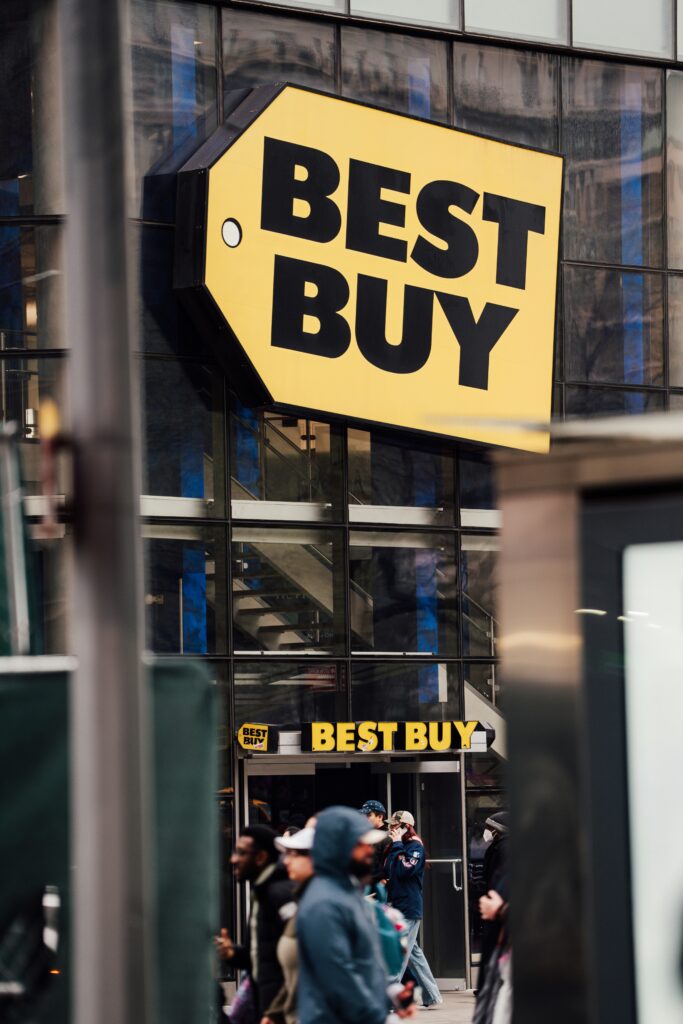Best Buy Co., Inc. (NYSE:BBY) is one of the largest consumer electronics retailers in the United States, with a history that stretches back to its founding in 1966 by Richard Schulze. Originally operating as Sound of Music, the company rebranded as Best Buy in 1983 and quickly grew into a household name recognized for its wide range of electronics, appliances, and technology services. Over the decades, Best Buy has evolved from a traditional big-box retailer into an omnichannel giant, blending brick-and-mortar locations with a robust e-commerce platform to remain competitive in a rapidly shifting retail landscape.
The company operates more than 1,000 stores across the U.S., Canada, and Mexico, with its domestic segment accounting for the majority of its revenue. Best Buy’s stores are strategically designed not only as retail outlets but also as service hubs, offering installation, repair, and tech support through its well-known Geek Squad division. This combination of product sales and value-added services has allowed the company to differentiate itself from online-only competitors and create a more integrated customer experience.
Best Buy has long been a trusted destination for consumers seeking the latest in computing, gaming, mobile phones, televisions, and appliances. In recent years, the company has expanded its assortment into emerging categories such as smart home technology, wearables, and health-related electronics, aiming to capture growing consumer demand in these sectors. Its ability to partner closely with major technology vendors such as Apple, Microsoft, Samsung, and Sony has kept its stores relevant by showcasing exclusive products, immersive demonstrations, and hands-on experiences that consumers cannot find elsewhere.
A cornerstone of Best Buy’s strategy has been its investment in omnichannel capabilities. Online sales now make up more than 30% of its total revenue, supported by options such as buy online, pick up in store, curbside pickup, and same-day delivery. This integration of physical and digital retail channels has positioned Best Buy as one of the leading omnichannel retailers in the world. The company has also ventured into new profit streams through its advertising platform, Best Buy Ads, and through the launch of its third-party marketplace, which expands product variety while tapping into new revenue opportunities.
In addition to consumer-facing growth, Best Buy has consistently emphasized shareholder value. The company has paid dividends for over two decades and currently offers one of the highest dividend yields among major U.S. retailers. Its steady balance sheet, disciplined cost management, and ability to adapt to changing market conditions have earned it a reputation as a resilient operator in a highly competitive industry. Despite the challenges of shrinking margins, tariff headwinds, and fierce competition from both traditional and online retailers, Best Buy continues to position itself as a leader in technology retailing with a focus on customer experience, vendor partnerships, and strategic innovation.
A Solid Quarter Fails to Mask Long-Term Weakness
Best Buy Co., Inc. surprised markets with better-than-expected second-quarter results for fiscal year 2026. The electronics retailer posted earnings per share of $1.28, beating analyst forecasts of $1.22, and revenue reached $9.4 billion, up 1.6% year-over-year. Investors responded with a 2.92% pre-market stock price increase, reflecting optimism about the company’s ability to execute in the near term. Yet beneath these headline numbers lies a deeper challenge: revenue growth remains tepid, earnings are still down 4% compared to the prior year, and management’s guidance reflects a cautious outlook. This indicates that while Best Buy can deliver short-term surprises, its long-term fundamentals may not justify bullish enthusiasm.

CHECK THIS OUT: How Globalstar (GSAT)’s Strategic Apple Partnership is Changing the Satellite Game and Intel (INTC)’s Epic Comeback: Why Wall Street May Be Dead Wrong About This “Dying” Chip Giant.
Margin Pressure From Product Mix and Competitive Pricing
One of the most significant red flags for Best Buy is the ongoing deterioration in gross profit margins. While sales rose, the adjusted operating income rate of 3.9% was down from last year, and margins declined by 30 basis points due to a higher mix of lower-margin categories such as gaming and computing. The successful launch of Nintendo’s Switch 2 boosted sales in entertainment and peripherals, but these are not high-profit segments. Meanwhile, Best Buy continues to compete aggressively on pricing with retailers like Walmart, Costco, Amazon, and Target, which forces it to compress product margins in order to defend market share. As management admitted, the back half of fiscal 2026 will likely see gross profit pressure continue or even worsen.
Dependence on Cyclical Product Cycles
Best Buy’s business model is highly dependent on innovation cycles in consumer electronics. The Q2 boost in gaming and computing sales came largely from new product launches, including handheld gaming devices, augmented reality glasses, and AI-enabled laptops. But the company itself admitted that outside of entertainment categories, core comps would have been down in low single digits. This means growth is not broad-based but cyclical, tied to product refreshes from vendors like Microsoft, Apple, and Nintendo. Once these cycles pass, Best Buy’s sales momentum tends to fade, leaving the company vulnerable to downturns in consumer enthusiasm or delays in new releases.
Tariff Uncertainty and Supply Chain Risks
Best Buy continues to face headwinds from U.S.-China trade tariffs, with electronics among the most heavily impacted categories. While management claims mitigation strategies have kept tariff impacts in check so far, costs are expected to increase in the second half of the year. Given that approximately 60% of Best Buy’s merchandise is sourced from China, tariffs could erode margins further and make products less affordable for consumers already dealing with inflation. Supply chain disruptions, while improved compared to the pandemic years, remain a lingering risk that could impact availability, pricing, and delivery efficiency.
Heavy Dependence on Vendor Partnerships
Another structural vulnerability for Best Buy lies in its reliance on vendor investments. The company proudly highlights that vendors such as Apple, Microsoft, Samsung, and LG fund in-store labor, merchandising, and promotions. In fact, vendor labor investment is expected to rise 20% this year. While this creates valuable cost-sharing, it also means Best Buy’s customer experience and in-store expertise depend on external funding. If vendors shift strategy or reduce spending, Best Buy could lose one of its most important competitive advantages. This dependency raises questions about the sustainability of its current operating model.
Marketplace Expansion Risks
Best Buy recently launched its marketplace initiative, tripling its online assortment with products from third-party sellers. While this aligns with the e-commerce shift, it also comes with risks. Management admits the marketplace may cannibalize first-party product sales, and early profitability is expected to be neutral due to startup costs. Competing with Amazon, Walmart, and eBay in the third-party seller arena will be an uphill battle, especially since Best Buy lacks the logistics scale of Amazon or the everyday low-price dominance of Walmart. Without significant differentiation, the marketplace strategy may dilute brand identity and compress margins even further.
Macroeconomic Pressures and Consumer Behavior
Best Buy’s reliance on discretionary spending makes it highly sensitive to macroeconomic conditions. Inflation, high interest rates, and a cooling housing market are pressuring consumers to delay or downgrade purchases of appliances, home theater systems, and other big-ticket items. While gaming and computing categories are currently strong, categories like appliances, tablets, and home theater continue to decline. The CEO acknowledged that customers are “resilient but deal-focused,” which suggests that promotions, not underlying demand, are driving sales. This behavior makes sustainable margin growth unlikely.
Shareholder Returns Amid Weak Fundamentals
Best Buy continues to return cash to shareholders through dividends and buybacks, including $568 million year-to-date in fiscal 2026. The company boasts a 5% dividend yield and has maintained dividend payments for 23 years. While this appears attractive to income investors, it raises concerns about capital allocation. With restructuring charges of $114 million in Q2 alone and ongoing investments needed for technology, supply chain, and marketplace expansion, continued shareholder returns could strain resources needed to fuel long-term growth. Returning capital while margins erode and revenues stagnate may mask, rather than solve, deeper structural problems.
Analyst Caution and Unimpressive Guidance
Best Buy’s management reaffirmed its annual guidance of $41.1 to $41.9 billion in revenue, with comparable sales expected to range from -1% to +1%. The adjusted operating income rate is projected at 4.2%, only slightly above Q2 levels. Analysts note that this guidance is underwhelming considering the Q2 beat, and suggests management lacks confidence in sustaining momentum. The company’s reliance on one-off product launches, vendor funding, and promotional pricing leaves limited room for upside surprises. Analyst price targets have been trending lower, reflecting skepticism about Best Buy’s ability to navigate tariffs, margin pressure, and intensifying competition.
Conclusion: A Company at Risk of Structural Stagnation
Best Buy’s Q2 FY2026 earnings demonstrate that the company can still deliver tactical wins, but long-term challenges remain formidable. Margin pressure, tariff exposure, reliance on vendor funding, and dependence on product cycles all weaken its investment case. Its marketplace strategy risks diluting profitability, and macroeconomic headwinds continue to constrain big-ticket sales. While the company’s dividend yield and brand reputation are strengths, they are not enough to offset structural stagnation. For investors, the cautious guidance and limited revenue growth trajectory suggest that Best Buy may struggle to deliver sustained shareholder value in the years ahead.
READ ALSO: POET Technologies (POET) Delivers 1.6T Optical Innovation—Is a Massive Revenue Surge Next? and BigBear.ai (BBAI) is Flying Under the Radar—But Not for Long. Here’s Why Bulls Are Piling In.






